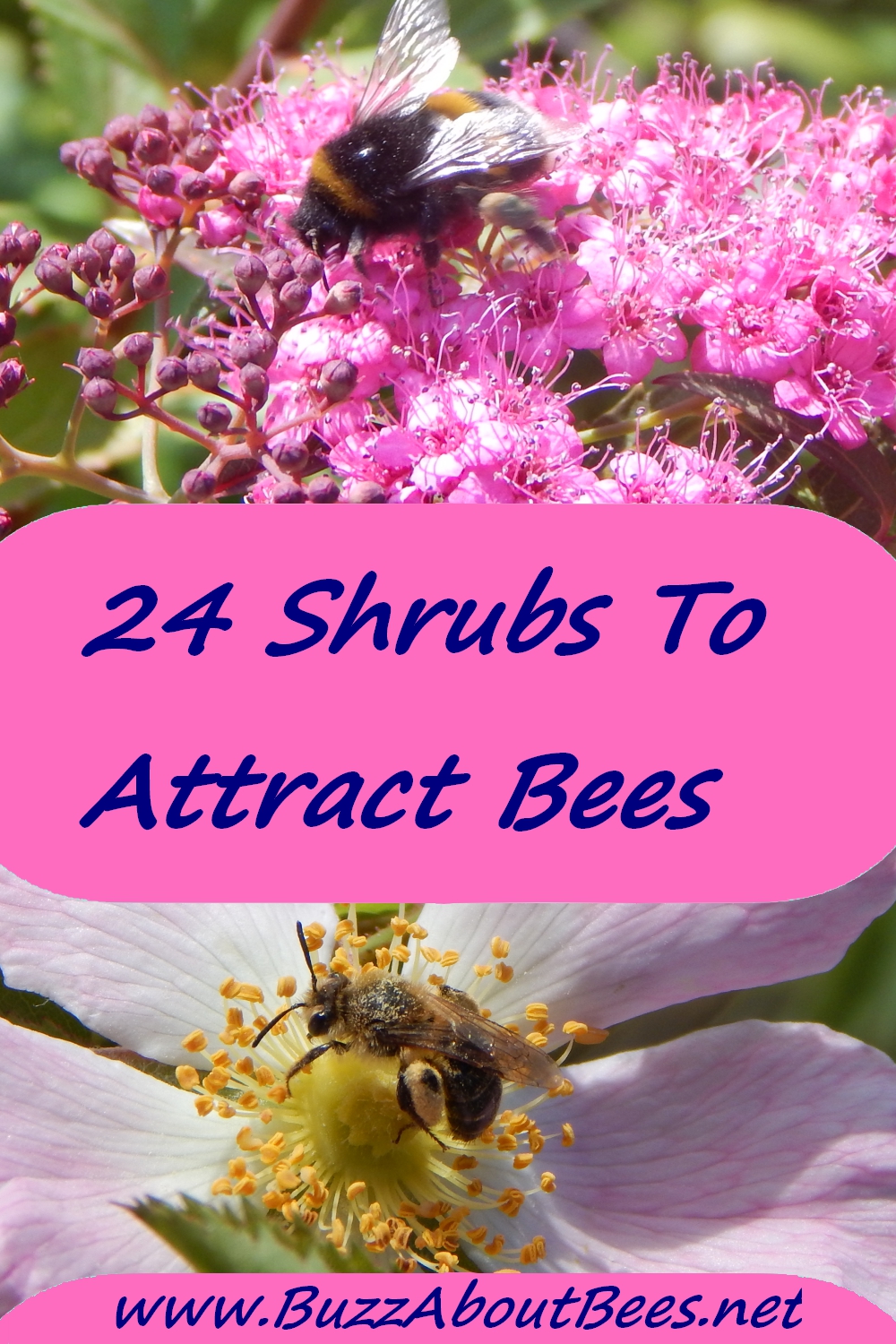24 Flowering Shrubs For Bees
There are many wonderful flowering shrubs for bees. Shrubs provide efficient foraging opportunities (lots of flowers in one place), and if you'd like to spend a little time watching bees, a shrub full of nectar and pollen rich flowers is great for a bit of bee-goggling!
This list originally featured 20 recommended shrubs, but I added several more. I have a separate page for climbers.
Flowering Shrubs For Bees And Other Pollinators - A Few Notes
This website receives many visitors from around the world – please check a shrub is suitable in your country (not considered an invasive species) before including it in your garden.
Berberis darwinnii - Darwin's barberry
Berberis darwinii is evergreen, and is one of my favourite flowering shrubs for bees, due to the mass of lovely orange flowers appreciated by bees and hoverflies alike, especially in early spring.
Early spring is when bumble bee queens are feeding frantically to build up their own energy reserves, and provide food stores to raise the first workers. Thus early sources of nectar and pollen help bumble bee queens establish their colonies.
This shrub is also useful for creating a prickly barrier plant if you are concerned about security.
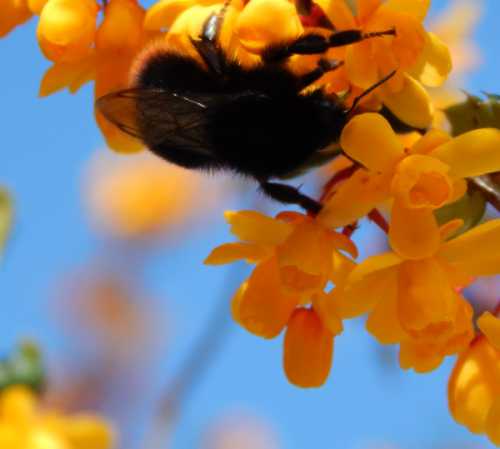 The orange flowers of Berberis provide food in spring. Above, a foraging Red tailed bumble bee queen.
The orange flowers of Berberis provide food in spring. Above, a foraging Red tailed bumble bee queen.The flowers are followed by decorative blue berries. I was not sure whether the berries were attractive to birds, until I watched a blackbird snaffling a few – whether the berries are appealing to birds in all countries, I do not know.
The leaves are small, and remind me of miniature holly (Ilex) leaves, although they are not so rigid. Sometimes, this shrub will flower again later in the year, although from personal observation, the flowers are not so abundant for the second flush.
Buddleia / Buddleja - Butterfly bush
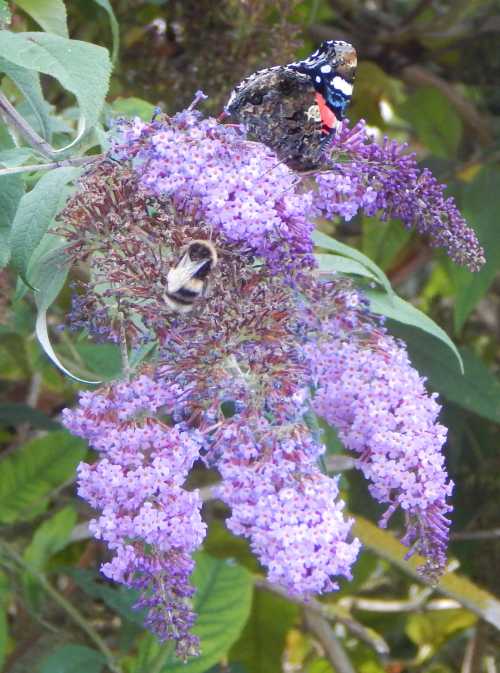 Bombus lucorum male and red admiral butterfly on Buddleia. The butterfly bush is also popular with bees.
Bombus lucorum male and red admiral butterfly on Buddleia. The butterfly bush is also popular with bees.It may be known as the 'butterfly bush' but the butterflies will often have to share it with bees, not to mention various pollinating flies and a few beetles!
You can read more about bees, butterflies and Buddleia here.
Calluna, Erica – Heathers
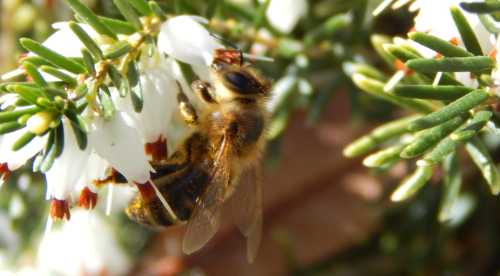 Honey bee foraging on heather in early spring
Honey bee foraging on heather in early springWe have winter flowering heathers which provide early food for honey bees and bumble bees. Excellent in a rockery.
Caryopteris x clandonensis
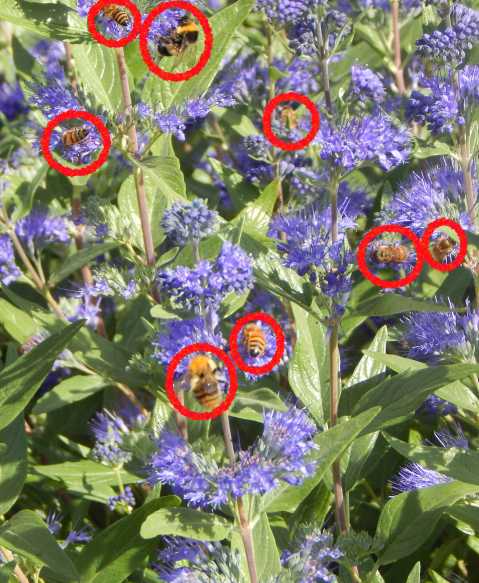 Many bees visiting Caryopteris x clandonensis
Many bees visiting Caryopteris x clandonensisThis lovely, versatile shrub has aromatic foliage. I am only familiar with the blue-flowered varieties, which are very popular with bees and butterflies, but pink specimens are available.
Although it's not a great photograph, above you can see just how popular this shrub really is with bees! So many bees were foraging, that it was impossible to take a picture that was also in focus on my little camera, and some quality was lost when I had to compress the image.
Find out why Caryopteris is one of my top 10 shrubs for bees.
Take cuttings of this fantastic shrub and share them with your friends!
Ceanothus - California lilac
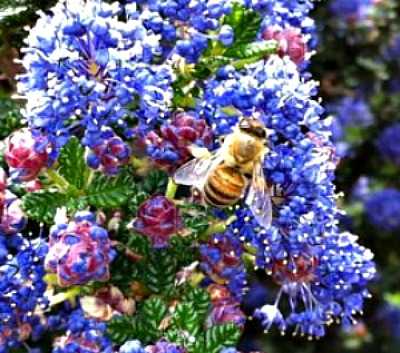 Honey bee foraging on California lilac.
Honey bee foraging on California lilac.Ceanothus is a superb evergreen flowering shrub for bees. Honey bees, bumble bees and solitary bees appreciate the lovely blue or blue and pinkish flowers.
I like the earlier flowering varieties as again, they provide food for bees when foraging opportunities may be limited.
However, if you have space, you can add a selection of different specimens to ensure extended flowering through spring to late summer. I have a page with more detail about ceanothus and bees here.
Cotoneaster
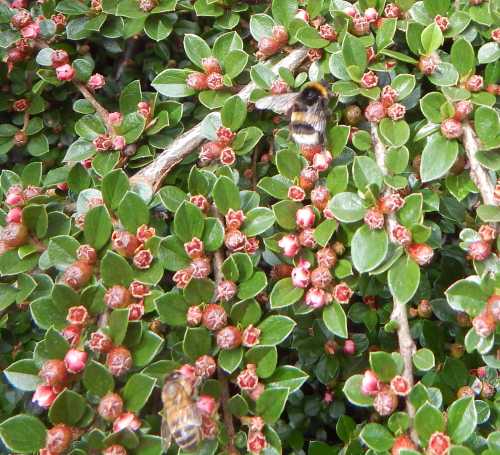 Honey bee and bumble bee on Cotoneaster horizontalis.
Honey bee and bumble bee on Cotoneaster horizontalis.Cotoneasters can be trees or shrubs, and some are evergreen. For a flowering shrub, I especially like Cotoneaster conspicuous ‘Decorus’ for attracting bees.
Cotoneaster flowers are followed by berries in autumn and winter, when hungry birds are especially grateful for them.
Clerodendrum bungei - Glory flower
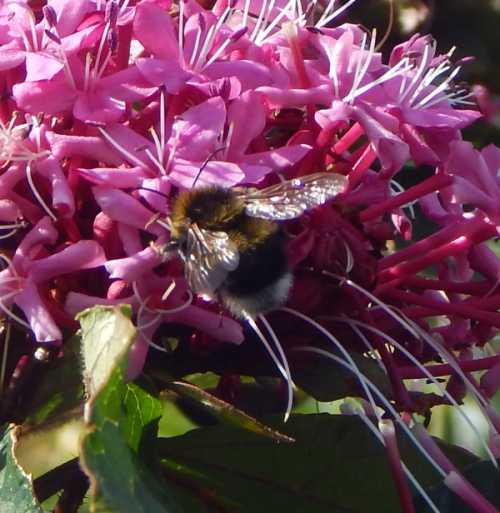 Bumble bee - Garden bumble bee Bombus hortorum on Clerodendrum bungei
Bumble bee - Garden bumble bee Bombus hortorum on Clerodendrum bungeiIt's true, there are more beneficial shrubs available for bees, but if you are seeking a striking specimen to create impact in your flower border, this might be suitable. It has large green leaves, with clusters of deep pink flowers that have long stamens.
Butterflies rather like the flower heads too.
It's fairly trouble free, being pretty resistant to diseases, and provides flowers from August to October.
Daphne bholua 'Jacqueline Postill' - Daphne
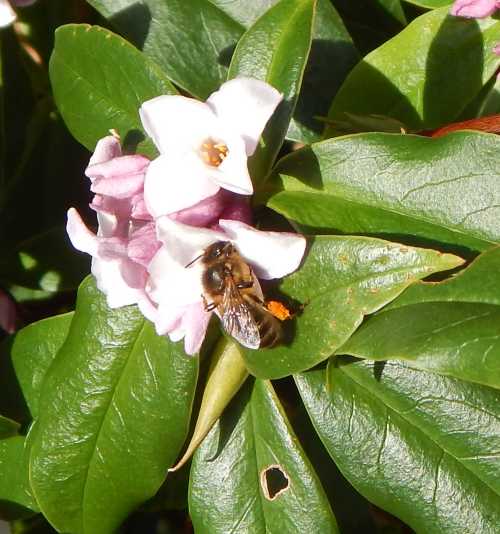 Honey bee worker foraging on Daphne.
Honey bee worker foraging on Daphne.An absolute beauty!
Bees and butterflies love Daphne, and to write that it has a divine fragrance may be an understatement! The scent is quite strong too. No wonder it can entice bees and even butterflies to forage on the pretty pink flowers...…...in January and February. I kid you not!
Read more about Daphne.
I have watched honey bees, bumble bees and butterflies feeding on it in very cool temperatures. The honey bees and butterflies arrived first!
My article on honey bees foraging in cool temperatures may also be of interest.
Escallonia - Red claws
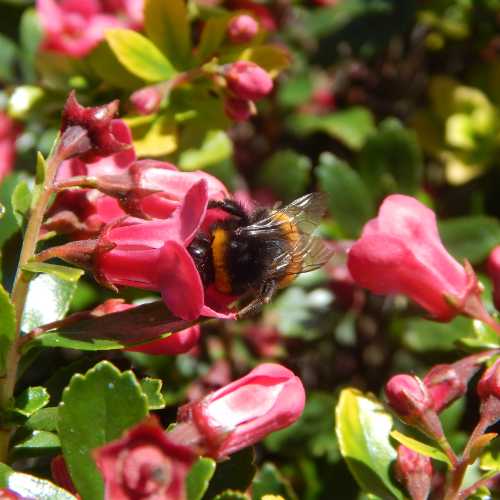 Escallonia is a favourite for bees.
Escallonia is a favourite for bees.
Escallonia is available with white flowers as well as deep crimson red. I only have experience of the red varieties, which have lovely flowers from spring through to summer (quite long flowering), and evergreen, glossy leaves.
I have a further page about Escallonia. Our neighbour has a good sized shrub, and Escallonia features in a number of public planting schemes around the area in which I live.
It's quite tolerant of a variety of soils as long as they are well drained. It likes sunshine, but I note my neighbour's shrub is in shade for part of the day. Great as a hedgerow plant.
Hebe
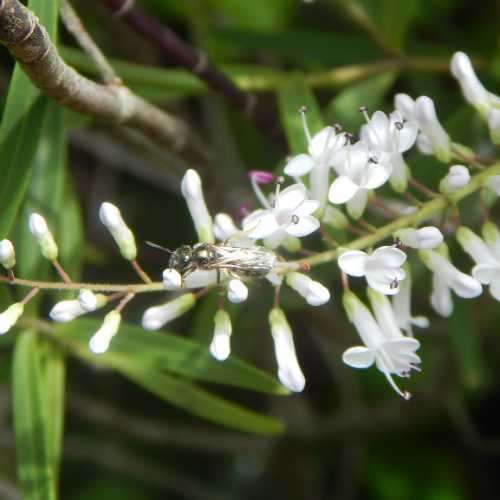 Hebe attracts all kinds of bees.
Hebe attracts all kinds of bees.Many flowering hebes are fantastic for bees and other pollinators. This particular shrub pictured above, gets covered in bees and hoverflies, and the variety may be 'Charming White'.
Many varieties are available however, offering purple, blue and white flowers. Not all hebes are flowering, so be careful in your selection.
Hydrangea - selected species
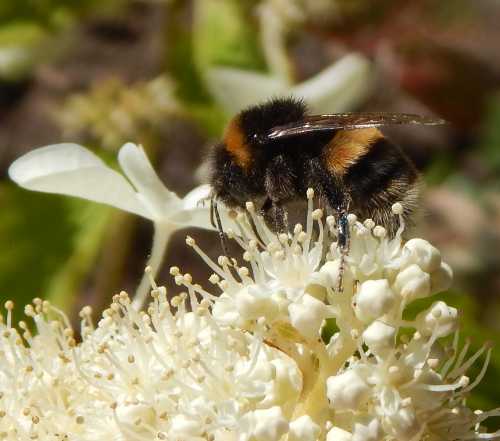 Bumble bees love Hydrangea paniculata
Bumble bees love Hydrangea paniculataSome hydrangea offer apparently nothing of value to pollinators in terms of nectar and pollen – they are decorative only. However, there are a few which are loved by pollinators, and Hydrangea paniculata 'Confetti' (above) is one of those.
I have watched honey bees and bumble bees foraging on ours, and I love the soft clumps of white blooms.
Choose your hydrangea shrub carefully to ensure you select one that offers value to pollinators.
Hypericum - St. John's Wort
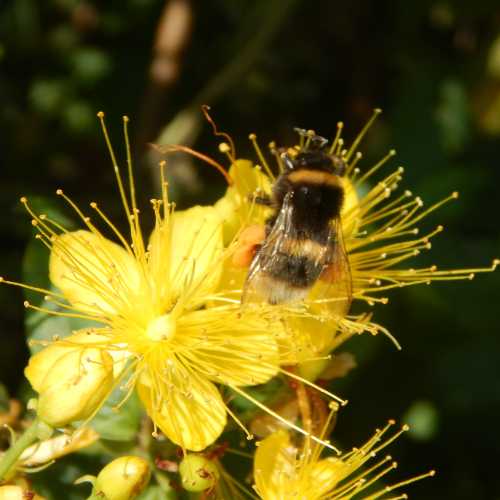 Hypericum flowers provide an abundance of pollen for bees.
Hypericum flowers provide an abundance of pollen for bees.
This cheery flowering shrub provides lots of pollen for a variety of bee species.
In my experience, not all varieties are useful for pollinators, but you can't go wrong with Hypericum perforatum.
The yellow flowers are followed by decorative yellow ‘hip’ type capsules for some species, or green or reddish/brownish berries for others.
Read more about Hypericum for bees.
Lavendula - Lavender
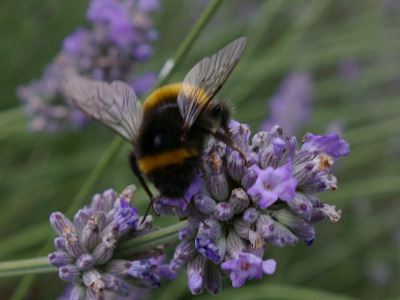 Lavender is popular with bees.
Lavender is popular with bees.A bee garden without lavender is hard to imagine! Indeed, lavender is one of the best herbs for attracting bees. Plenty of varieties to select from to ensure the longest display possible. Spoil yourself too, by planting it close to a seating area so you can enjoy the fragrance whilst you listen to the bees buzzing!
Ligustrum vulgare - Common Privet
Privet: Ligustrum vulgare (Common privet) - and also Ligustrum ovalifolium 'Aureum' provide food for a variety of pollinators.
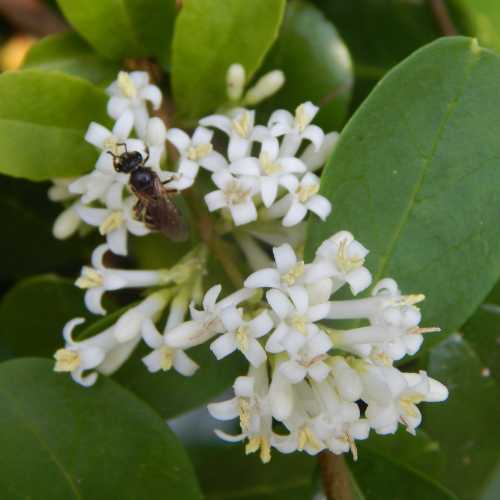 Ligustrum vulgare is sometimes overlooked, but this shrub make a useful addition to the wildlife hedge.
Ligustrum vulgare is sometimes overlooked, but this shrub make a useful addition to the wildlife hedge.It's an understated shrub in my view, but the white flowers are visited by bees, hoverflies
and butterflies. This bushy flowering shrub is often used
as a barrier hedge. It has small dark
berries after flowering.
Please note: Ligustrum vulgare is considered an invasive species in
some parts of the world, so please check before planting.
Leptospermum scoparium - Manuka Tree or New Zealand Tea Tree
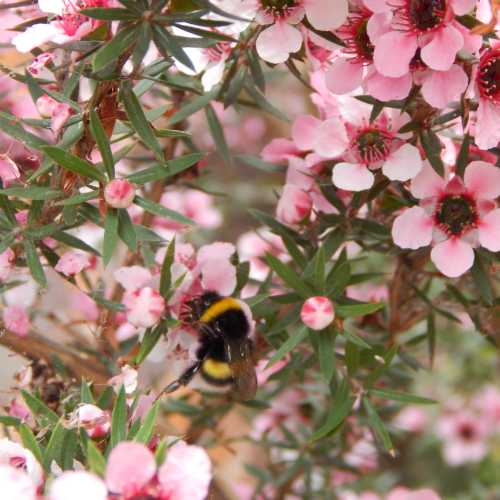 Bumble bee on manuka bush.
Bumble bee on manuka bush.Leptospermum scoparium is evergreen, and is the shrub from which honey bees make Manuka honey.
Bumble bees and various solitary bees love it too, as well as hoverflies. The pink flowers are lovely, and are surely dripping with nectar - you can actually see the nectar glistening in each single, small flower.
Quite long flowering from late Spring. However, it needs a sheltered spot and plenty of sunshine.
Mahonia (various)
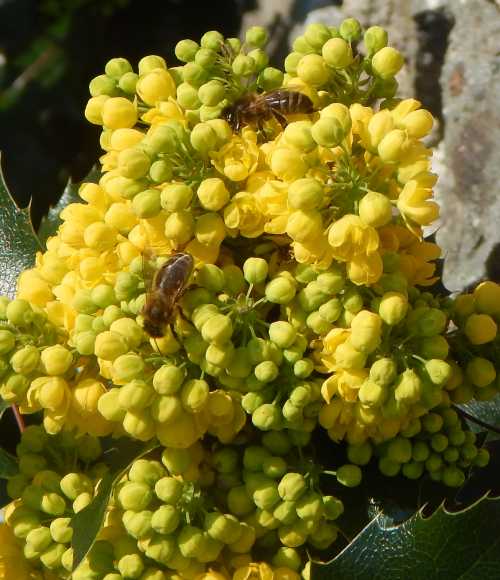 Honey bees on Mahonia aquifolium
Honey bees on Mahonia aquifoliumVarious Mahonias provide food for bees in winter. Mahonia japonica is especially popular, but I also like Mahonia aquifolium, as do bumble bees and honey bees.
Oregano/Marjoram
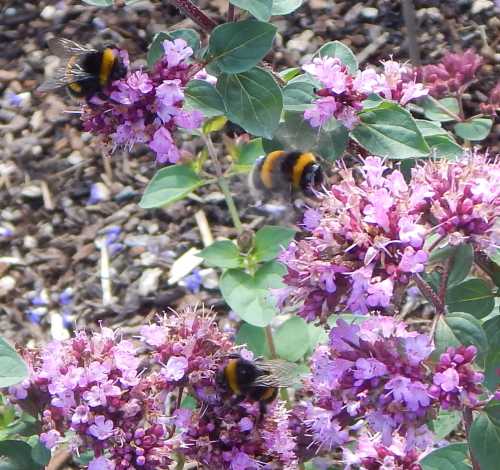 Another 'must have' to attract an abundance of bees, butterflies and hoverflies.
Another 'must have' to attract an abundance of bees, butterflies and hoverflies.This is definitely one of my top recommendations of all flowers for bees. In one study1, 21 different bee species were observed on 16 small plants of Lebanese oregano. Other varieties, such as Oreganum vulgare also attract many bees and butterflies.
Read more about Oregano (Marjoram).
Pyracantha - Firethorn
Firethorn - Pyracantha - gets covered in bees, and the gorgeous berries are adored by birds. Thorny, so it’s a good barrier shrub if you are concerned about security. Can tolerate some shade.
Try Pyracantha rogersiana, Pyracantha atalantioides, Pyracantha 'Golden Charmer' or Pyracantha 'Orange Glow' - but there are other bee-friendly varieties are available.
Prunus spinosa - Blackthorn, Sloes
Often seen in wild hedgerows, Blackthorn (Prunus spinosa) - sloes, provides a good source of nectar and pollen for bumble bees, honey bees, solitary bees, butterflies and moths. Can be a shrub or tree, and is ideal for wildlife garden.
White flowers in spring, and very valuable source of food when foraging opportunities are otherwise limited. A good, thorny hedge.
Ribes sanguineum - Flowering Currant
I especially find ‘Brocklebankii’ appealing. It has lovely pink
flowers and soft green leaves. If you are wanting to add 'softeness' to your border, this would be a very good choice, along with Spirea japonica (mentioned below).
A wonderful shrub for a cottage garden. The flowers of 'Brocklebankii' provide food for bees in spring.
Other varieties to consider are Koja, King Edward VII, Pulborough Scarlet or 'Tydeman's White', which has paler pink flowers, or 'White Icicle - Ubric' which is creamy white, and is also attractive for bees.
Rosa - Roses (certain types)
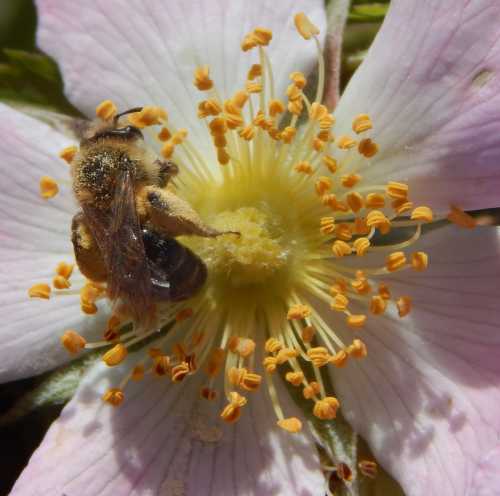 Painted mining bee - Andrena furcata - female, foraging on a wild rose
Painted mining bee - Andrena furcata - female, foraging on a wild rose
Not all roses are beneficial for bees, but they certainly like wild roses, and Rosa rugosa and a number of others. Rosa rugosa is simply one of
my favourite of all flowering shrubs for bees.
The roses are deliciously fragrant, and are visited by honey bees,
bumble bees and a wide range of wild bees of various species, like the painted mining bee pictured above. Having a fabulous rose shrub like this provides the opportunity to see species you may not be so familiar with.
The beautiful open blooms are perfect for bee-goggling and the nectar and pollen laden flowers are irresistible for our buzzing friends.
Spiraea japonica - Japanese Spiraea
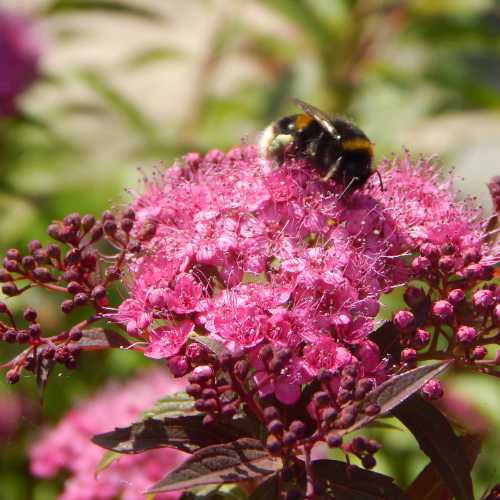 Bumble bees love Spirea japonica.
Bumble bees love Spirea japonica.Various pink flowered varieties are widely available and attractive to bees. We have the variety – ‘Magic Carpet’ in our front garden border, and it gets covered in bees and hoverflies for a couple of weeks or so in mid-summer.
I love the soft appearance of the flowers. I give it a clip in autumn to keep the shrub to a moderate size, but do follow the instructions for pruning for the specimen you select.
Sarcococca confusa and Sarcococca hookeriana - Sweet Box
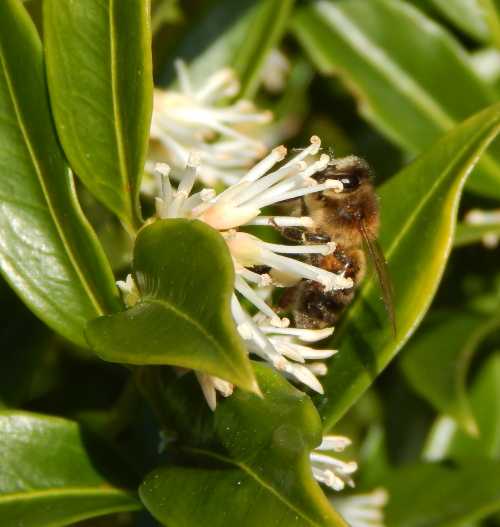 Sweet box has a lovely fragrance and is attractive to bees
Sweet box has a lovely fragrance and is attractive to bees
This wonderful fragrant shrub provides pollen for bees from January to February, when you may see hungry honey bees topping up with food for the colony on dry days. The flowers of Sweet Box may be small and relatively inconspicuous, but if you plant it close to a path, you will benefit from the lovely, delicious scent as you walk by.
Viburnum opulus - guelder rose
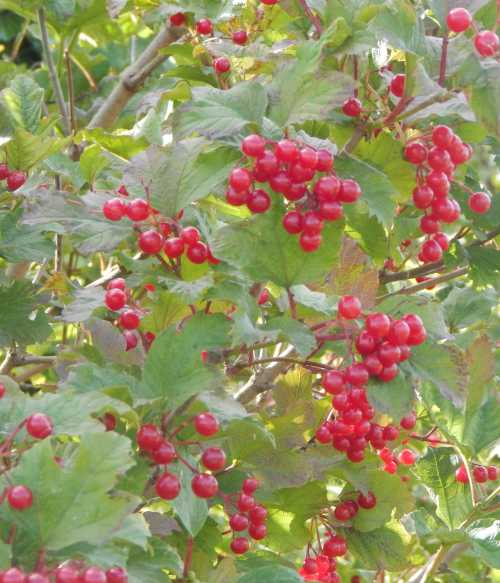 Guelder rose features lovely red berries through late autumn into winter - these are loved by birds.
Guelder rose features lovely red berries through late autumn into winter - these are loved by birds.A superb flowering shrub for bees, Guelder rose (Viburnum opulus), is perfect for a wildlife garden, as the gorgeous white flowers are enjoyed by bees and hoverflies, and the lovely red berries are an important food source for a variety of birds, including such as thrushes. It quite likes damp but well drained soil. It will tolerate some shade.
Further information: see my page notes on flowers loved by bees.
References
1. Abd Al-Majeed Al-Ghzawi , Shahera Zaitoun , Nawaf Freihat & Ahmad Alqudah (2009) Effect of pollination on seed set of Origanum syriacum under semiarid Mediterranean conditions, Acta Agriculturae Scandinavica, Section B — Soil & Plant Science, 59:3, 273-278.
